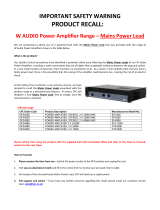Notice
Every effort was made to ensure that the information in this manual
was complete and accurate at the time of printing. However,
information is subject to change.
FCC Statement (Part 15) - Radio Frequency Interference
The Universal Telephone Interface generates and uses radio frequency
energy and if not installed and used in strict accordance with the
manufacturer's instructions, may cause interference to radio and
television reception. Testing is being conducted for compliance with
the limits for a Class B device in accordance with the specifications in
Part 15 of the FCC Rules and Canadian D.O.C. regulations. This testing
is designed to provide reasonable protection against such interference.
However, there is no guarantee that interference will not occur in a
particular installation. If this equipment does cause interference to
radio or television reception, which can be determined by turning the
UTI312 unit off and on, the user is encouraged to try to correct the
interference by one or more of the following measures:
- Reorient the radio or TV receiving antenna.
- Relocate the UTI312 unit with respect to the radio or TV receiver
or vice-versa.
- Plug the UTI312 unit into a different outlet so that it and the radio
or TV receiver are on different branch circuits.
If necessary, the user should consult the dealer or an experienced
radio/television technician for additional suggestions. The user may find
the following booklet, "How To Identify and Resolve Radio-TV
Interference Problems," helpful. This booklet was prepared by the
Federal Communications Commission (FCC) and is available from the
U.S. Government Printing Office, Washington, DC 20402. Stock order
No. 004-000-00345-4.
Federal Communications Commission (FCC) Statement
(Part 68)
This equipment is component registered with the Federal
Communications Commission (FCC) in accordance with Part 68 of its
rules. In compliance with the rules, be advised of the following:
Registered equipment may not be used with Coin Telephone Lines.
Equipment may be used with Party Lines in areas where state tariffs
permit such connections and when equipment is adaptable for such
service.
This equipment is registered as follows:
Registration Number - CD2PA13BUTI312
Ringer Equivalence - 1.4B
If trouble is experienced, the equipment should be disconnected from
the interface to determine if this equipment, or the telephone line is
the trouble source. If the equipment is determined to be
malfunctioning, it should not be reconnected until repairs are effected.
Repairs to this equipment, other than routine repairs, can be made
only by the manufacturer or its authorized agents.
If the equipment causes harm to the telephone network, the local
telephone company may temporarily discontinue your service and, if
possible, notify you in advance. If advance notice is not practical, you
will be notified as soon as possible. You will be given the opportunity
to correct the problem and informed of your right to file a complaint
with the FCC.
The local telephone company may make changes in its facilities,
operations, or procedures that could affect the proper functioning of
your equipment. If they do, you will be given adequate notice in writing
to allow you an opportunity to maintain uninterrupted telephone
service.
Important Safety Information
Always follow these basic safety precautions when installing and using
the system:
1. Read and understand all instructions.
2. Follow all warnings and instructions marked on the product.
3. DO NOT block or cover the ventilation slots and openings. They
prevent the product from overheating. DO NOT place the product
in a separate enclosure or cabinet, unless proper ventilation is
provided.
4. Never spill liquid on the product or drop objects into the
ventilation slots and openings. Doing so may result in serious
damage to the components.
5. Repair or service must be performed by a factory authorized
repair facility.
6. The product is provided with a UL-CSA approved, 3-wire ground
type plug. This is a safety feature. DO NOT defeat the safety
purpose of the grounding type plug. DO NOT staple or otherwise
attach the AC power supply cord to building surfaces.
7. DO NOT use the product near water or in a wet or damp place
(such as a wet basement).
8. DO NOT use extension cords. The product must be installed
within 6 feet of a grounded outlet receptacle.
9. DO NOT install telephone wiring during a lightning storm.
10. DO NOT install telephone jacks in a wet location unless the jack
is specifically designed for wet locations.
11. Never touch uninsulated wires or terminals, unless the line has
been disconnected at the paging or controller interface.
12. Use caution when installing or modifying paging or control lines.





















